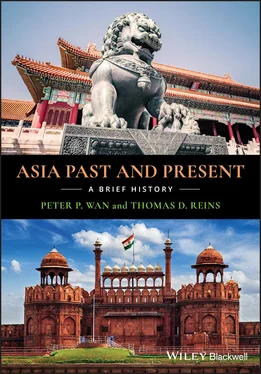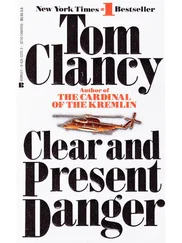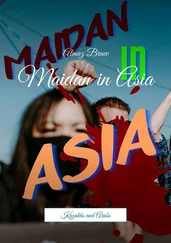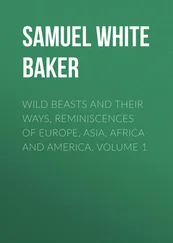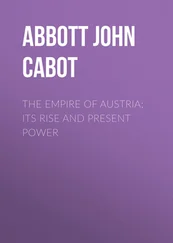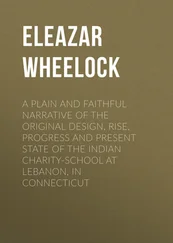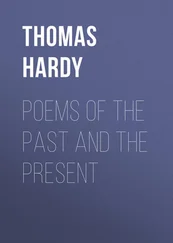Bai Juyi(772–846) was an exceptionally successful scholar‐official. Some of his poems, like Du Fu’s, express a deep sympathy for the plight of the common people. But his most memorable works are two romantic ballads: one about the unfulfilled love of an emperor, and the other about the quiet despair of a scholar‐official in exile. He is famed for writing in a colloquial style that is so simple and plain that even an uneducated old woman can appreciate them.
The Tang government practiced religious tolerance. While both Buddhism and Daoism were popular, the royal family increasingly moved from patronizing Buddhism to favoring Daoism, as did the royal family in the early Han Dynasty. Buddhism originated in India and entered China by way of the Silk Road toward the end of the Han Dynasty. The decline of the Han Dynasty discredited Confucianism and created a “belief vacuum,” which was fertile soil for Buddhism to take root in. Buddhist teachings that all people are equal, all people can enter Heaven, and all people should love one another had a strong appeal to people who lived precariously in a war‐ravaged land. Its belief in reincarnation gave hope to the hopeless. Its cosmology, abstract thinking, and emphasis on spirituality provided welcome relief to Han Chinese from their dry and rigid earth‐bound Confucianism. Its rich store of art, literature, and architecture also facilitated its spread. Later, the Kingdom of Northern Wei promoted it vigorously with the express purpose of using it as a tool to shape a national identity distinct from the Confucian culture of the Han Chinese.
This Indian religion propelled China’s sculptural art into maturity. At Yungang and Longmen, huge Buddhist statues and temples are carved into the sides of sheer mountains or into the inside walls of grottoes. They represent the highest levels of cultural achievement in ancient Chinese sculptural art and continue to inspire awe in us today.
Dunhuangwas located at a crossroad along the Silk Road in the middle of the Gobi Desert that bustled with commercial and cultural activity. Buddhism entered China through this gateway, and spread across the country. In the early twentieth century, a monk accidentally discovered a treasure trove of ancient artifacts in the grottoes at the foot of a local mountain. It was mainly Buddhist manuscripts, ancient books and documents, and exquisite frescoes and sculptures in Chinese and many other languages. It also included writings of popular entertainment, such as poetry, music, and drama. The richness and significance of the deposit have given birth to a new academic discipline—Dunhuang Studies.
Buddhism coexisted with Daoism, and became a broad‐based and deeply rooted religion across the country in Tang China. Its followers came from all walks of life—from royalty to commoners, and from peasants to merchants. Buddhist monasteries mushroomed across the country.
In Early Tang, the royal family had a passion for translating Buddhist texts from their original Sanskrit to Chinese. Xuan Zang (602–664), a Buddhist monk, made the arduous round‐trip pilgrimage from Chang’an to India, where he studied Buddhism and returned with 567 Buddhist scriptures. The emperor ordered the formation of a “translation bureau” where Xuan Zang and his followers devoted their lives to translating the scriptures. This might be said to be the beginning of China’s long tradition of translating foreign‐language works into Chinese. His account of his pilgrimage is a complete and systematic account of the history, geography, natural conditions, and local practices of the vast regions that cover today’s Xinjiang, Central Asia, Iran, and India. It is a major source of information about the region of that period.
Buddhist monasteries enjoyed royal patronage and exemption from tax and labor service. Men and women entered monastery life in droves, abandoning normal, productive ways of life. This abnormal way of life was unsustainable. Since the government could not reach the monasteries with its taxing arm, it shifted more of the tax burden onto the remainder of the peasantry. This increased tensions across the country—between the government and the peasants, and between the government and the Buddhist establishment. As tensions heightened, Buddhist monasteries and teachings came under harsh scrutiny and attack. Its foreign origin was a favorite target. The emperor cracked down on Buddhism in 845. He destroyed 4600 Buddhist monasteries, confiscated millions of acres of tax‐exempt land, and forced 260,000 monks and nuns to return to secular life and productive work. Buddhist influence went into sharp decline.
Fundamentally, this was a power struggle between church and state over control of human and material resources. The fact that the emperor himself was an ardent Daoist devotee could reasonably be suspected of contributing to the harshness of his crackdown. (It is noteworthy that China’s religious institutions, unlike their European counterparts, never outranked its political institutions; the emperor and his government were never subservient to the abbots and monasteries.) Buddhist metaphysical philosophy and religious practices would gradually become Sinicized and merge into Chinese culture as an organic part of it. The Neo‐Confucianism of the Song Dynasty would be strongly influenced by Buddhist philosophy.
The Tang Dynasty produced China’s one and only female ruler of the empire. Wu Zetian (Wu Zhao, 624–705) was the widowed concubine of Emperor Tang Taizong, wife of his son, and empress dowager of his grandson. She first held the reins of power from behind the throne for over 20 years, then openly seized the throne, took the title of emperor, founded her own dynasty, and ruled for another 15 years. In total, she was China’s de facto ruler for over 35 years.
She ruled with an iron fist. Her administration crushed opposition by employing spies, merciless and unscrupulous officials, and torture. She stamped out rebellion with troops. She also used favoritism to foster personal loyalty. She expanded the examination system to rope in a new crop of scholar‐officials who were beholden only to her, and used them to replace men who had served in previous regimes. Her long reign was stable and prosperous: there were no peasant rebellions. When she was 82, her prime minister mounted a coup that forced her to return the throne to her son and go into retirement. Confined to her quarters in the rear of the palace, she died later the same year.
Historians have attacked her for her non‐aristocratic origin, her scheming and cruelty, and her licentious lifestyle. But the most serious accusation was that, as a woman, she dared to usurp the throne, which was the exclusive domain of males. But no amount of mudslinging can deny her success as a ruler.
The Shift of China’s Economic Center from the Yellow to the Yangtze River Valley
Over time, wealth and power corrupted the rulers of the Tang Dynasty. They became complacent, extravagant, and indulgent. Scholar‐officials in high office and eunuchs close to the royal family formed cliques, and focused their energies on grabbing power and fortunes. The Tang royal court, like the Roman court, began relying on nomadic generals and their troops to defend their borders. One royal court favorite was An Lushan (703–757), a frontier general of non‐Han origin. He turned against the court and marched his troops on the capital Chang’an. His troops looted and burned the world’s richest city to the ground. Although he was eventually defeated, the eight‐year An Lushan Rebellion (755–763) marked the end of Tang’s Golden Age.
The government’s power and the nation’s economy plummeted. Peasant rebellions broke out and swept across the land. Huang Chao (820–884) led the most devastating of them. His rebellion adopted guerrilla warfare, marauding across the country, and wreaking havoc wherever they showed up. They ransacked Guangzhou and killed some 200,000 Arab and Persian merchants who had come to the port to trade. Then they captured the capital city of Chang’an without even laying siege to it, and went on a spree of looting and slaughter, leaving it in ruins again. Now Huang Chao proclaimed himself emperor of a new dynasty, but as is always the case, the rebel army became fractured by internal strife and was crushed by government troops. Huang Chao committed suicide. It is noteworthy that Huang Chao’s rebellion championed the idea of “leveling the rich and the poor,” which was a big draw to the peasants.
Читать дальше
